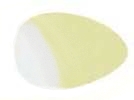This page hosted by

 An egg that is opaque like this one could mean a couple of different things. First off, it could mean the egg is fertile and the chick has developed to the extent that you can't see through the egg at all. A fertile egg that is over a week old starts to get opaque like this. Notice that there is still that little air space at the wide end. A day or two before hatching, the air space disappears altogether.
An egg that is opaque like this one could mean a couple of different things. First off, it could mean the egg is fertile and the chick has developed to the extent that you can't see through the egg at all. A fertile egg that is over a week old starts to get opaque like this. Notice that there is still that little air space at the wide end. A day or two before hatching, the air space disappears altogether.
An egg that looks opaque like this one could also be an egg that is rotten inside, or an egg in which the baby has died. You can't tell, so leave the egg in the nest till it is far overdue for hatching!
 This egg is opaque, as the one we just discussed, but it has a large, off-center air pocket. It could contain a dead-in-shell baby, or it could be an old rotten egg.
This egg is opaque, as the one we just discussed, but it has a large, off-center air pocket. It could contain a dead-in-shell baby, or it could be an old rotten egg.
 This egg is an old one that was never fertile. Nothing ever developed and so the egg stayed clear. The air pocket is too large and off-center.
This egg is an old one that was never fertile. Nothing ever developed and so the egg stayed clear. The air pocket is too large and off-center.
So now what???
I recommend not throwing out any eggs that look like they have veins or that are opaque (provided the opaque ones have no large, off-center air pockets). Let them stay in the nest until after you think the hatch date has passed. What If I Don't Want Baby Birds?
If you don't want babies to hatch from your birds' eggs, then you don't need to candle them. You need to addle them. Simply pick up the eggs and shake each one, hard, shortly after they are laid. This is like scrambling the egg in the shell. No baby will develop even if your birds are fertile and having sex. Once the parents have sat on the addled eggs for a few weeks, you can remove them
Take me to The Flock's homepage.
![]() Get your own Free Home Page
Get your own Free Home Page
